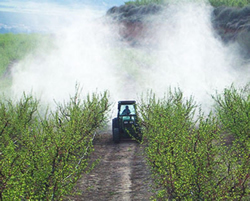 Biosecurity Queensland is urging farmers and other landholders to check agricultural chemical labels, track weather conditions and apply best practice during the current spraying season.
Biosecurity Queensland is urging farmers and other landholders to check agricultural chemical labels, track weather conditions and apply best practice during the current spraying season.
Chief Biosecurity Officer at the Agency, Malcolm Letts said managing the risk of spray drift was critical to best practice spraying for growers and contractors.
“Spray drift management strategies reduce the risk of unintended impacts to neighbours and the environment, and ensures more herbicide lands where it should, to maximise weed control and minimise chemical costs,” Mr Letts said.
“Developing a spray plan, including checking the instructions that come with the spray, keeping an eye on the weather forecast and selecting the most appropriate nozzles and pressures before you start spraying, are all crucial.”
He said conversations with neighbours about the timing of spray operations were encouraged.
“All users of agricultural chemicals should be aware of their obligations under the Chemical Usage (Agriculture and Veterinary) Control Act 1988,” Mr Letts said.
“This includes requirements to follow all instructions appearing on agricultural chemical labels, including spray drift constraints, and to make and keep spray records.”
He said significant penalties could apply — up to $86,250 for individuals and $431,250 for companies.
Further information can be accessed at Biosecurity Queensland’s Facebook or on Instagram (@BiosecurityQld) and Twitter (@DAFQld).









